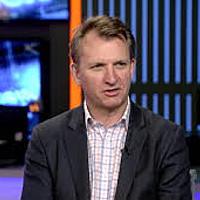4 reasons the equity bull market is alive and well
While this year is only a few weeks old, the key theme in markets already appears to be well established. That theme is a mix of:
- High inflation;
- Sharply higher rates and bond yields, and
- Marked sector rotation (out of growth and into the value/cyclical parts of the global equity market).
With that, though, and as the cartoon below suggests, there are growing fears that the bull market in equities has finished, and that the primary trend is now down. In particular, the NASDAQ100 has already fallen 16% (peak to trough) from its November high while the drawdown is much larger in certain second line tech names (e.g. Zoom, Peloton, Block). As such, and given the move higher in rates and bond yields, the bears are drawing parallels to the bursting of the tech bubble in early 2000.
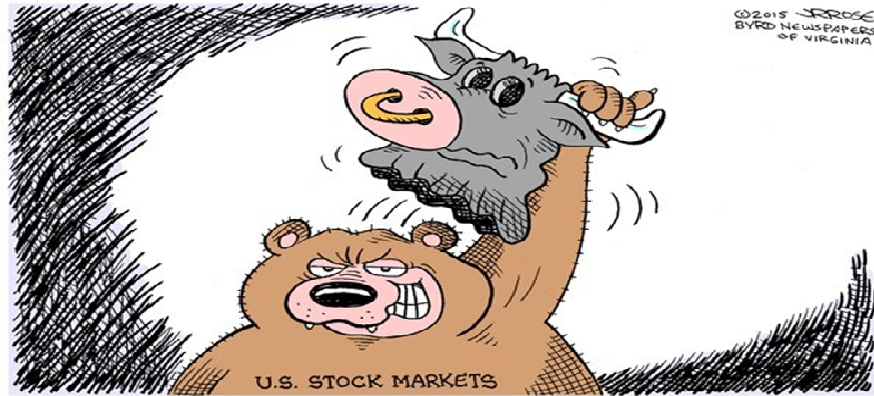
Adding to that ‘bubble bursting’ thesis, the bears argue that US economy is late in the economic cycle. In particular, they are worried about (i) high inflation (and an associated real income squeeze); (ii) high wage inflation impacting corporate profit margins; (iii) the potential for a sharp tightening of Fed policy; and (iv) a potential slowdown, if not recession, in the US & global economy (especially given that the Fed is in tightening mode).
Are the bears, therefore, correct? Will the Fed hike four or five times this year into a slowing economy? Or, put another way, is the Fed about to make a policy mistake?
Or, as the bulls suggest, on the other side of the debate, is it appropriate that central banks normalise policy? Indeed, is an emergency monetary policy no longer fitting for the US economy, given rapid real economic growth (e.g. +6.9% annualised last quarter) and high inflation.
If the bulls are correct, and the US and global economy can absorb/withstand policy normalisation, then it will drive a number of key themes in markets next year (and beyond). In particular, history would point to a high likelihood of: An uptrend in US Treasury yields; higher real bond yields; a flatter yield curve; and an ongoing cyclical bull market in equities, led by cyclically sensitive sectors (e.g. see fig 1 below, which shows the recent tight correlation between TIPS yields and the performance of cyclical sectors relative to long-duration growth).
Fig 1: US 10 year TIPS yield (%) versus cyclicals relative to long-duration growth
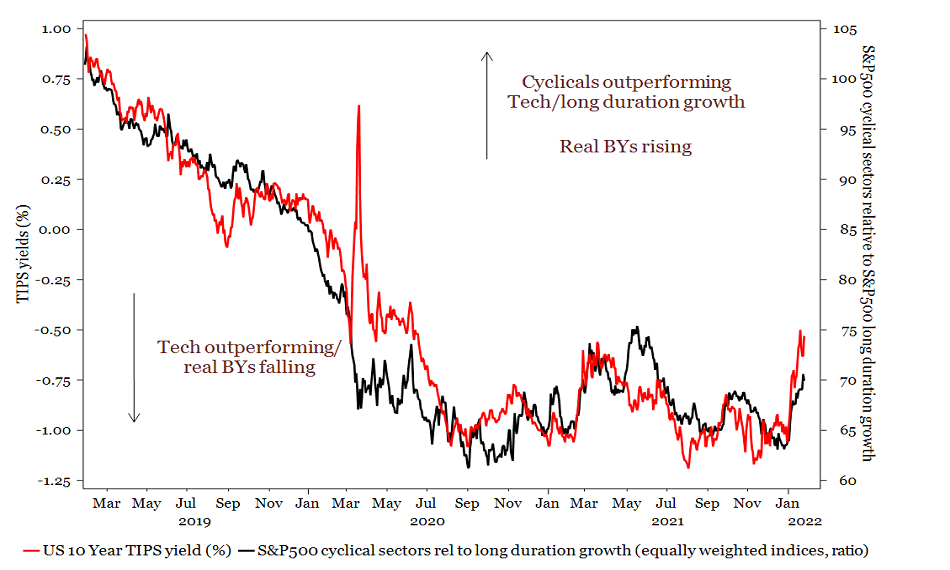
Four reasons to be Bullish
In our view, the bulls are correct and policy normalisation should be the main macro theme in markets this year. We therefore (continue to) recommend OW risk positions in strategic portfolios. The rationale for that view is four fold. In particular:
1. The US economy is in strong health, with boom like economic and earnings growth conditions likely to persist in 2022. Of note US corporate sector cashflow is close to record high levels on latest data, profit growth is rapid, the profit share of GDP is at a record high, and (GDP profit share) margins are expanding. Added to which, US households are cyclically and structurally strong (on many fronts) and should continue to drive growth in the US economy. Elsewhere, the Eurozone growth outlook is reasonably robust while it’s increasingly likely that China will experience a soft landing, followed by a phase of economic stability/reflation this year.
As such, and given that the global economy is considerably stronger than it was in the last economic cycle, it’s likely, over time, to successfully absorb a longer/larger rate hiking cycle (e.g. compared to 2016-18). If correct, real and nominal bond yields should trend higher and the bull market in equities should persist (i.e. led by the cyclical/value parts of the market).
2. Inventory restocking is likely and adds to the case for strong economic momentum and an uptrend in bond yields. The relationship between bond yields and inventories is reasonably tight and can be traced back to the 1960s. That is, phases of inventory restocking are, almost always, associated with an uptrend in bond yields.
In that respect, inventories in Western economies are currently ‘too low’. The latest NFIB small optimism survey, for example, points to an extreme lack of inventory in the US (see fig 2 below) while, in Europe, manufacturing inventories are close to a multi-decade low. Naturally, low inventory partly reflects supply chain tensions (and well as strong demand given high levels of stimulus). As such, and as the global economy moves from pandemic to endemic, the ability of companies to rebuild stock levels should improve (i.e. as those tensions ease). That should generate strong economic activity. Furthermore, there’s also some early evidence that the Omicron strain, once infection rates have reached high levels, may support the transition from pandemic to endemic (given that it’s a highly transmissible, but mild, strain which therefore effectively results in ‘forced vaccination/herd immunity’ of the global population).
Fig 2: NFIB small business optimism: Inventory satisfaction
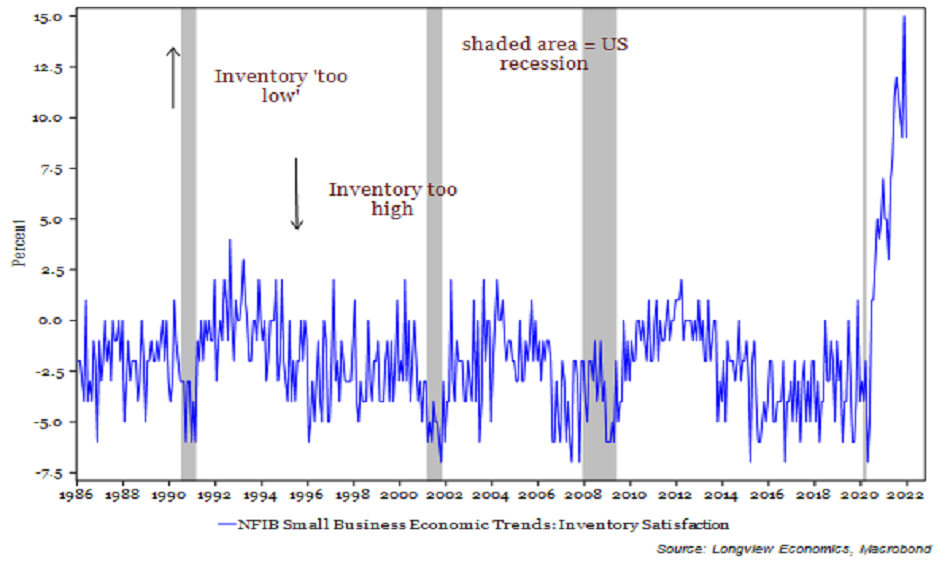
3. Liquidity remains plentiful. Cyclical bull markets in equities are typically driven by three key factors: (i) Ongoing economic & earnings growth (which is likely next year – see points 1 & 2 above); (ii) plentiful liquidity; and (iii) the absence of shocks.
Shocks, by definition, are difficult to forecast. With respect to (ii), we track several key barometers of ‘the tightness of money’, which are the inputs into our Liquidity Indicator, shown in fig 3 below. Currently, this indicator has a reading of +13, one of its lowest readings on record, highlighting plentiful liquidity in the US economy and banking system – and suggesting that the risk of a Fed policy mistake is low. In other words, significant tightening is necessary before monetary policy becomes ‘too tight’. All of that adds to the case that the conditions for policy normalisation are in place.
Fig 3: Longview Liquidity Indicator, shown with US recessions
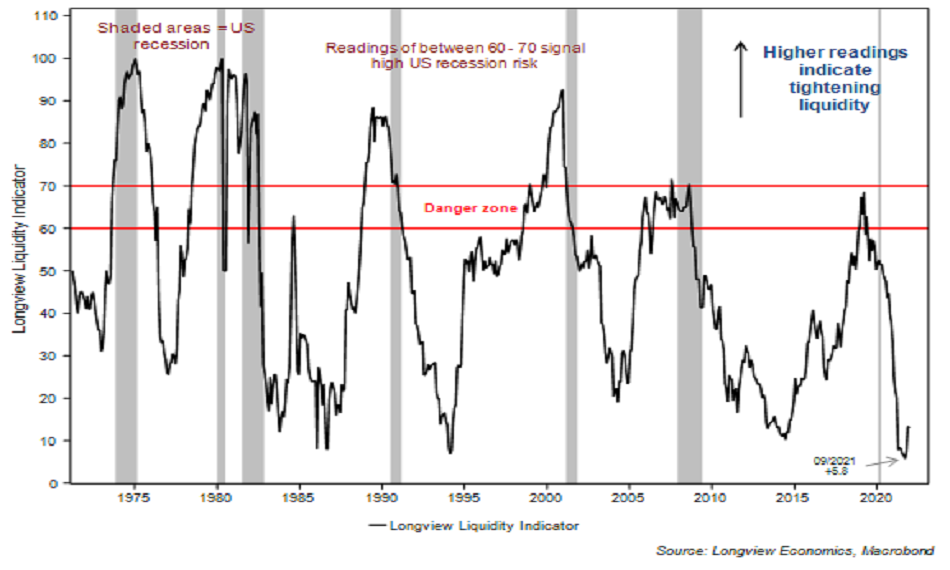
4. US inflation should soften, at least in the first half of this year. That, in turn, should reduce the pressure on the Fed to raise interest rates aggressively in 2022, and therefore underpin the case for further strength in equities/risk assets. In particular, many of the key drivers of higher goods inflation are now fading (and include, amongst other factors, a fall in some shipping and freight rates, softer order backlogs and supplier delivery times, and reduced growth rates in key commodity prices). That should result in weaker goods (and headline) inflation readings.
Of note in that respect, goods prices are the key current source of high US inflation (along with shelter prices). Service sector inflation, in contrast, is reasonably tame (but accounts for 60% of the CPI basket).
In December, for example, services (ex. shelter) was just +0.14% M-o-M. In the past 6 months, it’s averaged 0.2% M-o-M (i.e. June – December). The underlying trend in service sector prices is therefore relatively muted (and not dissimilar to 2019 levels, as fig 4 below shows). As such, if we’re correct and goods inflation softens, then the pressure on the Fed to tighten next year should fade somewhat. That would further support the uptrend in global equities and other risk asset prices.
Fig 4: US CPI services inflation vs. services less rent of shelter (M-o-M %)
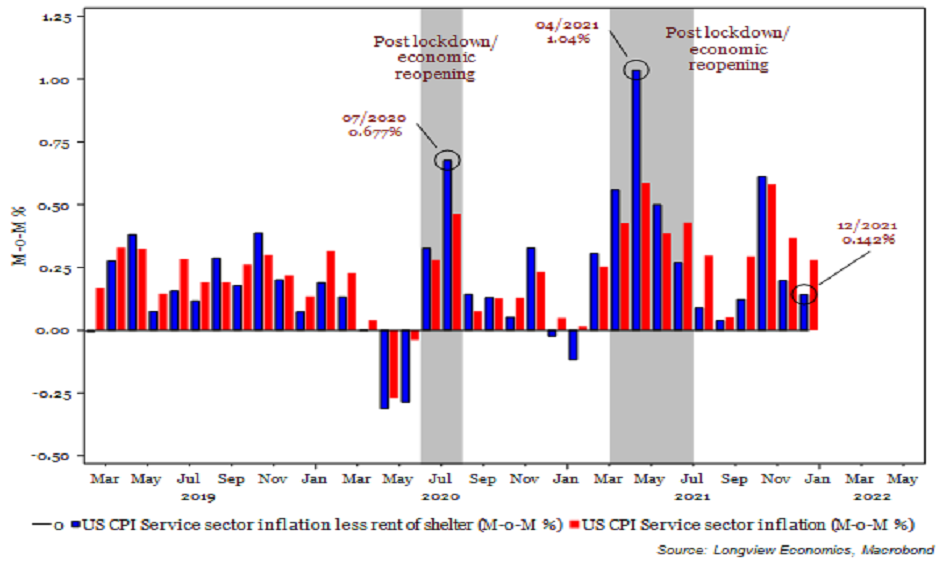
All of that suggests that the bull market in global equities is ‘alive and well’ and that the primary trend in bond yields is up.
This economic cycle, therefore, is likely to share parallels with the early noughties. That is, key characteristics of this expansion should include: (i) robust growth; (ii) elevated inflation (albeit inflation should ease in the near term); (iii) an uptrend in bond yields; and (iv) an ongoing bull market in global equities which is led by the value sectors and cyclically sensitive parts of the equity market (as yields move higher, see fig 1).
Risks to that view are multiple. In particular, and as always, there’s the potential for macro shocks. It’s possible, for example, that the Omicron variant mutates into a more deadly strain, which negatively impacts global economic activity. Other ‘shock risks’ include the potential for:
- A deterioration in the Russia-Ukraine situation (and a significant move higher in oil prices*);
- 'Taper blow-ups’ – with Fed tightening possibly resulting in stress in certain vulnerable parts of the global economy (e.g. Turkey, which is currently in the midst of a currency crisis);
- A sharp weakening of US productivity growth (which may increase inflationary pressure/speed up the pace of Fed tightening); and/or
- A significant/further slowdown in the Chinese economy.
Other risks to our constructive view on equity markets include a possible fall in the profit share of GDP, in the US and elsewhere. While a high/rising profit share is positive for equity markets, the bears argue that it’s reached a peak (at its highest level since 1950), and will now shrink as a result of rapid wage growth.
Fig 5: US profit share of GDP (%) shown with US recession bands
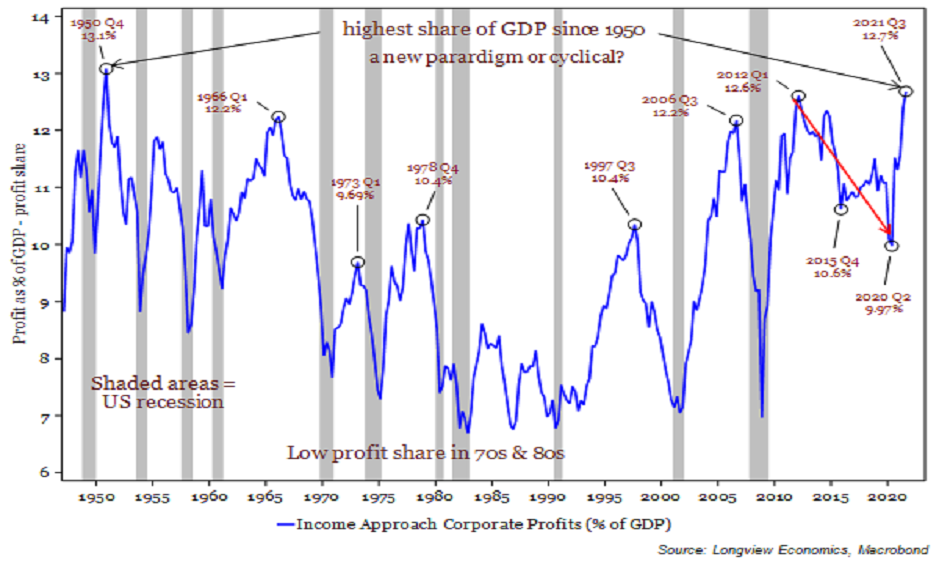
While that’s possible, though, a falling profit share does not preclude an ongoing equity bull market. From 2012 – 2015, for example, profits trended down as a share of GDP, yet the equity market continued to trend up and make new all time highs. There were similar dynamics in the late 1960s and late 1990s (see fig 5).
Those risks, though, are just that (i.e. risks to our central view that the equity bull market is ongoing). As such, and with a ‘risk-on’ environment expected to persist this year, we also expect:
- EM equities to trend higher: In particular, as the Chinese authorities continue to ease policy (having already begun to pull down on some of their key policy levers), it’s likely that the Chinese economy will stabilise and then begin to reflate later this year. That supports the expectation for stronger trade, economic, and earnings growth (both in China and the other key EM economies with close ties to China).
Linked to that constructive outlook for China/EM, a number of key commodities should also perform well. In particular, base metals such as copper and iron ore are likely to trend higher as markets price in a stable/improving outlook in the Chinese economy.
Furthermore, and adding to the case for strength in EM assets and commodity prices, we expect the US dollar to give back some of its gains this year. The recent dollar rally has been (mostly) driven by growing expectations of Fed hikes (particularly relative to other major economies). If our inflation view is correct, though (see above), then some of those hikes are likely to be priced out (therefore resulting in a weaker dollar). Of interest in that respect, the dollar has become a crowded long trade in recent months, while dollar sentiment readings are high (i.e. generating a contrarian sell message).
Credit: Our view on high yield credit is somewhat neutral at this juncture, given that spreads are reasonably tight. Given our view on bond yields (i.e. that they are likely to trend higher), we favour underweight positions in high grade credit.
- Sector leadership within the equity market: Given the reasonably strong US growth outlook for the US economy (see above), and an environment of generally higher inflation (over coming years), we expect this cyclical bull market in equities to be led by value and the more cyclically sensitive sectors (while tech and other long duration growth underperform).
*In the event, for example, that Russia weaponises its energy production/energy prices.
Never miss an insight
Enjoy this wire? Hit the ‘like’ button to let us know. Stay up to date with my content by hitting the ‘follow’ button below and you’ll be notified every time I post a wire.
Not already a Livewire member? Sign up today to get free access to investment ideas and strategies from Australia’s leading investors.
